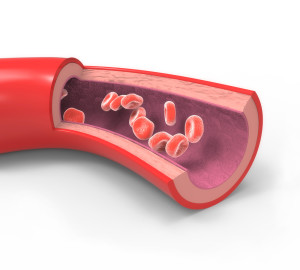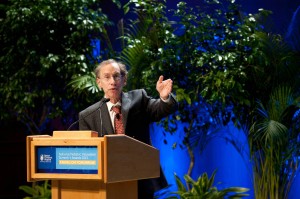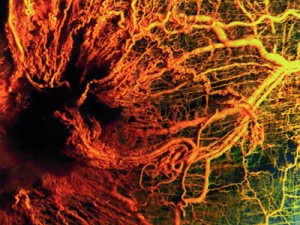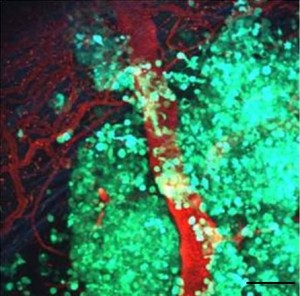 Chronic, unresolved inflammation can be quite harmful, right down to the cellular level. At the macro level, it has links to cancer, diabetes, heart disease and other degenerative conditions.
Chronic, unresolved inflammation can be quite harmful, right down to the cellular level. At the macro level, it has links to cancer, diabetes, heart disease and other degenerative conditions.
This is why the body keeps a tight rein on the inflammatory response and maintains a host of factors that resolve inflammation once the need for it (for instance, to clear an infection or heal an injury) has passed.
We know pretty well which factors work between cells to turn on and turn off inflammation. That knowledge has led to the development of drugs like ibuprofen, acetaminophen and naproxen, all of which temper pro-inflammatory factors.
However, when you look at the signals and signaling pathways within cells, things get more complex, especially when it comes to factors that turn off inflammation. We haven’t completely grasped the full complement of proteins that transmit these internal anti-inflammatory signals. If we did, we could potentially add new drugs to our pharmacopeia to regulate or resolve inflammation or maintain cells in a non-inflamed state, and perhaps help prevent rejection of transplanted organs and tissues.
David Briscoe, MD, and his team at Boston Children’s Hospital’s Transplant Research Program, has taken the field one step closer to grasping those internal pathways by studying a cellular protein called DEPTOR. Full story »
 When James Mandell, MD, outgoing CEO of Boston Children’s Hospital, introduced keynote speaker Robert Langer, PhD, at the National Pediatric Innovation Summit + Awards, he shared one of Langer’s favorite quotes. “When scientific literature says something isn’t possible, you just have to create possibilities that don’t exist.”
When James Mandell, MD, outgoing CEO of Boston Children’s Hospital, introduced keynote speaker Robert Langer, PhD, at the National Pediatric Innovation Summit + Awards, he shared one of Langer’s favorite quotes. “When scientific literature says something isn’t possible, you just have to create possibilities that don’t exist.”
Langer, the David H. Koch Institute Professor at the Massachusetts Institute of Technology (MIT) and the most cited engineer in history, walked the audience through the trials and tribulations he encountered in his four-decade career as an innovator.
When he finished his ScD in chemical engineering in 1974, Langer was heavily courted by the oil and gas industries, which aimed to leverage the knowledge of young chemical engineers to address the oil crisis. But that work didn’t appeal to him.
Instead, Langer was taken with the idea of teaching chemistry to underserved youth. Unfortunately, he could not secure a position with any of the 40-odd programs to which he applied.
Eventually, a colleague suggested to him that Judah Folkman, MD, a pioneering cancer researcher at Boston Children’s, sometimes hired “interesting people.” Langer took the bait and joined Folkman’s lab in the mid-1970s.
“I may have been the only engineer in the place. I learned so much because everyone’s backgrounds were so different,” he recalled. Full story »
Tumor cells need the right environment in order to spread. But a protein that some tumors themselves produce can make some environments inhospitable to metastasis. (Albh/Wikimedia Commons)
With cancer, it’s generally not the primary tumor that kills people, but metastasis—the spread of cancer to locations far from the original tumor.
Finding ways of stopping metastasis has proven immensely challenging. On some level, it’s a problem with the models that we use to study metastatic cancer. But it’s also a matter of understanding why particular tumor types spread where they do—like prostate tumors to the bones or breast cancer to the brain—and what about the microenvironment—the combination of cells, proteins and other factors—makes different sites in the body metastatically friendly to different tumors.
Randolph Watnick, PhD, and his research team in Boston Children’s Vascular Biology Program have been asking this question, and in the process have found that a protein called prosaposin can make sites unfriendly to metastasis. Interestingly, it’s a protein that some tumors actually make themselves.
But even better, Watnick has found that a tiny fragment of prosaposin—a peptide that is a mere five amino acids long—has the same anti-metastatic power of the full protein, making it highly attractive for drug development. He and his collaborators reported the full story in a recent paper in the journal Cancer Discovery.
Full story »

Like a seed, a tumor can remain dormant for years. But what's the trigger that causes a tumor to switch from dormancy to aggressive growth? (OpenCage/Flickr)
Believe it or not, you—and I, and everyone around us—quite likely has cancer right now.
While just a third of us will be diagnosed with cancer in our lifetimes, more than 90 percent of us harbor dormant, microscopically small tumors—maybe just a few cells in size—that will never be cause for alarm.
“Most people will live their lives without these tumors growing any larger,” says Randy Watnick, PhD, a researcher in the Vascular Biology Program at Boston Children’s Hospital. “But why? What is the difference between tumors that remain dormant and those destined to grow?”
It’s no small question: As screening and diagnostic technologies improve (allowing us to detect tumors smaller and earlier), the risks of overtreatment rise. That’s fueling a need for better ways to sift potentially dangerous tumors out from ones that will stay quiet. Full story »

Medicine is a balancing act; how much of a drug is too much? A group of compounds called EETs provide a clear example of the possible dangers of giving patients too much of a good thing. (chris grabert/Flickr)
Usually when your doctor talks to you about lipids, he or she is talking about cholesterol (be it the good or bad kind). But cholesterol is only one kind of lipid. There are millions of these fatty molecules working in everyone’s body right now.
One family of lipids, known as EETs (or epoxyeicosatrienoic acids), is produced by the endothelial cells that line blood vessels, where they help control inflammation and the response to injury. Because EETs are also potent regulators of blood pressure, pharmaceutical companies are looking intently at compounds that raise bloodstream EET levels as a way of managing the cardiovascular aspects of more than 20 conditions, ranging from diabetes and stroke to kidney and eye diseases; some are currently in clinical trials.
There may be a catch, however: Some studies suggest that EETs promote angiogenesis, or blood vessel formation, and that the enzymes that process EETs have a relationship to cancer.
Dipak Panigrahy and Mark Kieran of Children’s Vascular Biology Program and the Dana-Farber/Children’s Hospital Cancer Center wanted to understand this relationship better: Could boosting EETs be dangerous? Full story »
 If you were a cancer patient receiving anti-angiogenic therapy, and you heard media reports that this treatment might make you worse and not better, what would you do? Recent peer-reviewed studies have indicated that inhibitors of vascular endothelial growth factor (VEGF), the central factor controlling formation of new blood vessels, actually promote tumor invasiveness and increase metastasis in animal models – far from their intended effect of forcing the cancer into remission. Vector covered this surprising twist last fall. Understandably, as these findings got out, some patients called their physicians and asked to be taken off the drugs.
If you were a cancer patient receiving anti-angiogenic therapy, and you heard media reports that this treatment might make you worse and not better, what would you do? Recent peer-reviewed studies have indicated that inhibitors of vascular endothelial growth factor (VEGF), the central factor controlling formation of new blood vessels, actually promote tumor invasiveness and increase metastasis in animal models – far from their intended effect of forcing the cancer into remission. Vector covered this surprising twist last fall. Understandably, as these findings got out, some patients called their physicians and asked to be taken off the drugs.
Knowing all this, I was eager to attend this week’s World Anti-Angiogenesis Summit, which promised a panel discussion addressing the controversy. It’s one that interests me, as I am the licensing manager for the Vascular Biology Program at Children’s Hospital Boston. Full story »

Medulloblastoma cells (green) are growing around this cerebellar blood vessel and inducing growth of new vessels nearby (red). Courtesy Matija Snuderl & Rakesh Jain.
An update last week on angiogenesis research revealed surprising twists in the story of fighting cancer by cutting off the tumor’s blood supply. The latest findings, reported by top researchers at an international pediatric oncology meeting in Boston, show that the story is much more nuanced. If big questions seem to go begging in the emerging story, you’re not alone in thinking so!
Anti-angiogenic drugs can kill some tumors by cutting off their blood supply. But surprisingly, in two animal studies using very high doses, the drugs turned some tumors more malignant and metastatic, said Rakesh Jain, PhD, by increasing the hypoxic zone; low oxygen conditions somehow promote tumor progression in these models. Full story »
 Chronic, unresolved inflammation can be quite harmful, right down to the cellular level. At the macro level, it has links to cancer, diabetes, heart disease and other degenerative conditions.
Chronic, unresolved inflammation can be quite harmful, right down to the cellular level. At the macro level, it has links to cancer, diabetes, heart disease and other degenerative conditions.











